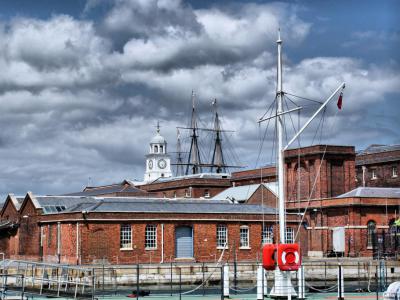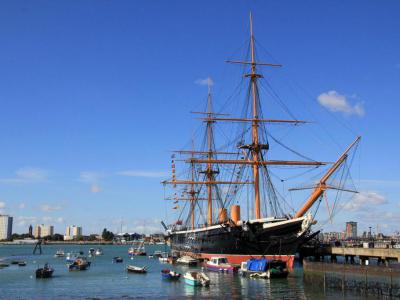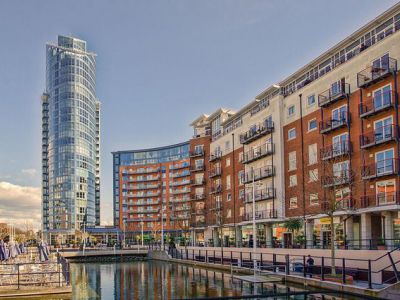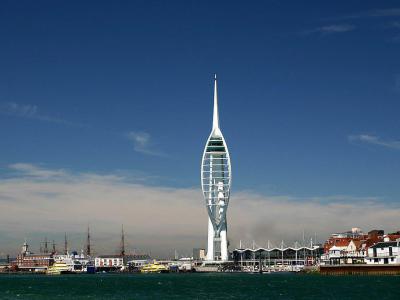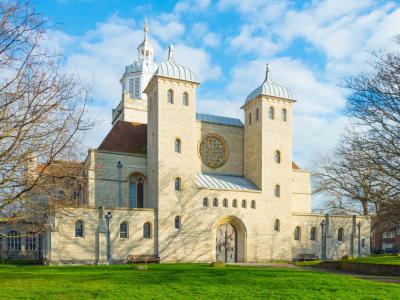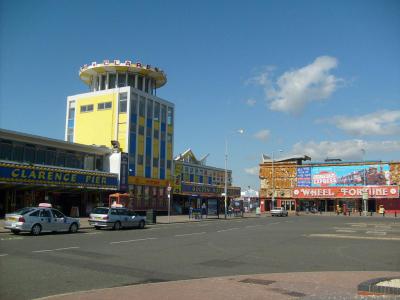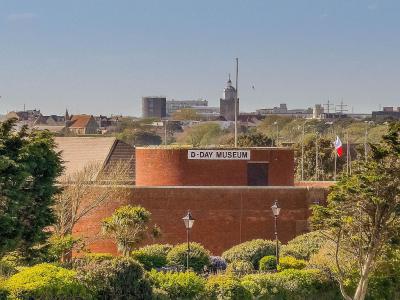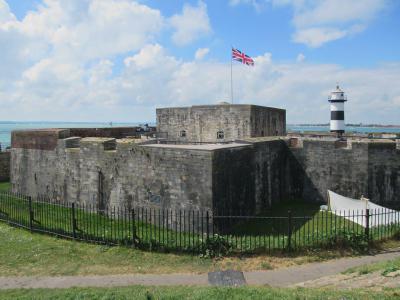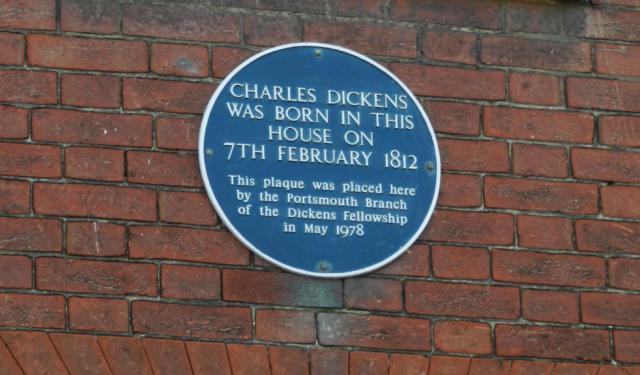Portsmouth Introduction Walking Tour (Self Guided), Portsmouth
The Anglo-Saxon Chronicle claims a warrior named Port and his two sons killed a noble Briton in Portsmouth in 501 AD. Winston Churchill, in his "A History of the English-Speaking Peoples," wrote that Port was a pirate who founded Portsmouth in the same year.
King AEthelwulf sent a force to drive off Viking raiders in Portsmouth in the 9th century. The Danes loved Portsmouth, but they had to leave. The next invaders were Normans under William the Conqueror. They stayed.
King Richard I granted a royal charter making Portsmouth a market town in 1194. John, Richard's successor, established Portsmouth as a permanent naval base. William of Wrothham built the first docks in 1212.
Portsmouth has been an important Royal Navy dockyard and base for centuries. It had to fend off a few invasion attempts. The French tried in 1545 at the Battle of the Solent. The Spanish Armada called in 1588. By 1900, the city was one of the most fortified in the world.
HM Naval Base Portsmouth has the National Museum of the Royal Navy and the Portsmouth Historic Dockyard. Historical warships on display include Henry VIII's MARY ROSE, Nelson's VICTORY, the oldest commissioned warship, the iron-clad HMS WARRIOR, and others.
Gun Wharf Quays, a vast shopping compound in the heart of Portsmouth, has over 100 stores and restaurants. The pub and club scene after dark should not be missed. Spinnaker Tower offers thrills high above the Quays. Clarence Pier has rollercoasters, miniature golf, and fun arcades.
Portsmouth has left its mark on Charles Dickens, Sir Arthur Conan Doyle, Rudyard Kipling, H. G. Wells, and other famous writers and artists. Travel, adventure, literature, discovery, and wonder, you will find them all together in Portsmouth.
King AEthelwulf sent a force to drive off Viking raiders in Portsmouth in the 9th century. The Danes loved Portsmouth, but they had to leave. The next invaders were Normans under William the Conqueror. They stayed.
King Richard I granted a royal charter making Portsmouth a market town in 1194. John, Richard's successor, established Portsmouth as a permanent naval base. William of Wrothham built the first docks in 1212.
Portsmouth has been an important Royal Navy dockyard and base for centuries. It had to fend off a few invasion attempts. The French tried in 1545 at the Battle of the Solent. The Spanish Armada called in 1588. By 1900, the city was one of the most fortified in the world.
HM Naval Base Portsmouth has the National Museum of the Royal Navy and the Portsmouth Historic Dockyard. Historical warships on display include Henry VIII's MARY ROSE, Nelson's VICTORY, the oldest commissioned warship, the iron-clad HMS WARRIOR, and others.
Gun Wharf Quays, a vast shopping compound in the heart of Portsmouth, has over 100 stores and restaurants. The pub and club scene after dark should not be missed. Spinnaker Tower offers thrills high above the Quays. Clarence Pier has rollercoasters, miniature golf, and fun arcades.
Portsmouth has left its mark on Charles Dickens, Sir Arthur Conan Doyle, Rudyard Kipling, H. G. Wells, and other famous writers and artists. Travel, adventure, literature, discovery, and wonder, you will find them all together in Portsmouth.
How it works: Download the app "GPSmyCity: Walks in 1K+ Cities" from Apple App Store or Google Play Store to your mobile phone or tablet. The app turns your mobile device into a personal tour guide and its built-in GPS navigation functions guide you from one tour stop to next. The app works offline, so no data plan is needed when traveling abroad.
Portsmouth Introduction Walking Tour Map
Guide Name: Portsmouth Introduction Walking Tour
Guide Location: England » Portsmouth (See other walking tours in Portsmouth)
Guide Type: Self-guided Walking Tour (Sightseeing)
# of Attractions: 8
Tour Duration: 2 Hour(s)
Travel Distance: 4.2 Km or 2.6 Miles
Author: Lilly
Sight(s) Featured in This Guide:
Guide Location: England » Portsmouth (See other walking tours in Portsmouth)
Guide Type: Self-guided Walking Tour (Sightseeing)
# of Attractions: 8
Tour Duration: 2 Hour(s)
Travel Distance: 4.2 Km or 2.6 Miles
Author: Lilly
Sight(s) Featured in This Guide:
- Portsmouth Historic Dockyard
- HMS Warrior
- Gunwharf Quays
- Spinnaker Tower
- Portsmouth Cathedral
- Clarence Pier
- D-Day Museum
- Southsea Castle
1) Portsmouth Historic Dockyard (must see)
Portsmouth has been one of the four major Royal Navy Dockyards or Bases throughout the history of England. Richard I of England built the first dock in Portsmouth in 1194 and then scampered off to the Holy Land. His testy brother John added walls in 1212. In 1242 King Edward II required all southern ports to build the largest possible ships.
Portsmouth is said to have built the first dry dock in the world, ordered by Henry VII in 1495. The first warship built in Portsmouth was the Sweepstake, a carrack launched in 1497. Ships from Portsmouth helped drive off the Spanish Armada of 1588.
The Portsmouth Historic Dockyard is that part of HM Naval Base Portsmouth, which is open to the public. The National Museum of the Royal Navy opened in 1911. Historic vessels and more modern ships are on exhibit in the Dockyard.
The HMS Victory, Lord Nelson's flagship at the battle of Trafalgar, is the star of the show. Victory has been open to the public in her dry dock, still seaworthy after 200 years. HMS Warrior was the first iron-plated, iron-hulled warship. Launched in 1860, she was open to visitors in 1987. HMS M33, First WW I monitor, opened in 2015.
The Mary Rose, a short-lived jewel of Henry VIII's Tudor fleet, is not seaworthy. She sank in 1545 while Henry watched. He is said to have wept. Salvaged in 1982, the ship rests on display in a specially built museum structure that houses thousands of artifacts found in the wreck.
The Portsmouth Naval Base Property Trust is responsible for the maintenance and upkeep of all historic buildings and exhibits of the Historic Dockyard. The Trust established the Memorial Flotilla, a collection of antique boats. A new museum, micro-brewery, pub and restaurant, and holiday residences have been recently built or are "on the way" to be launched.
Portsmouth is said to have built the first dry dock in the world, ordered by Henry VII in 1495. The first warship built in Portsmouth was the Sweepstake, a carrack launched in 1497. Ships from Portsmouth helped drive off the Spanish Armada of 1588.
The Portsmouth Historic Dockyard is that part of HM Naval Base Portsmouth, which is open to the public. The National Museum of the Royal Navy opened in 1911. Historic vessels and more modern ships are on exhibit in the Dockyard.
The HMS Victory, Lord Nelson's flagship at the battle of Trafalgar, is the star of the show. Victory has been open to the public in her dry dock, still seaworthy after 200 years. HMS Warrior was the first iron-plated, iron-hulled warship. Launched in 1860, she was open to visitors in 1987. HMS M33, First WW I monitor, opened in 2015.
The Mary Rose, a short-lived jewel of Henry VIII's Tudor fleet, is not seaworthy. She sank in 1545 while Henry watched. He is said to have wept. Salvaged in 1982, the ship rests on display in a specially built museum structure that houses thousands of artifacts found in the wreck.
The Portsmouth Naval Base Property Trust is responsible for the maintenance and upkeep of all historic buildings and exhibits of the Historic Dockyard. The Trust established the Memorial Flotilla, a collection of antique boats. A new museum, micro-brewery, pub and restaurant, and holiday residences have been recently built or are "on the way" to be launched.
2) HMS Warrior (must see)
The HMS Warrior was the biggest, fastest, and most powerful warship of her kind when she was launched in 1860. She was years ahead of the American Merrimack and Monitor, way rapid and more seaworthy. The Warrior was Britain's first iron-hulled, armored warship, offering protection from explosive shells. She was a worldwide game-changer.
Intimidating as she was, she never fired an angry shot. Invincible she may have been, her active duty career was short. Soon she was absolete and quickly outclassed by newer ships, faster with thicker armor and heavier guns. In 1871, the Warrior was downgraded to reserve status. In 1924 she was up for sale as scrap.
The Warrior wasn't scrapped but converted into a floating oil tank at Pembroke Dock. The oil depot closed in 1978, and the ship underwent restoration by the Maritime Trust. In 1987 the Warrior returned to Portsmouth Harbour. Saved from the knackers, she is now a proud ship museum and a naval monument.
A complete conservation and restoration program, costing upward of 4.2 million pounds, was completed in 2019. The Warrior is now represented as she was in her Round-Britain Tour of 1863.
Intimidating as she was, she never fired an angry shot. Invincible she may have been, her active duty career was short. Soon she was absolete and quickly outclassed by newer ships, faster with thicker armor and heavier guns. In 1871, the Warrior was downgraded to reserve status. In 1924 she was up for sale as scrap.
The Warrior wasn't scrapped but converted into a floating oil tank at Pembroke Dock. The oil depot closed in 1978, and the ship underwent restoration by the Maritime Trust. In 1987 the Warrior returned to Portsmouth Harbour. Saved from the knackers, she is now a proud ship museum and a naval monument.
A complete conservation and restoration program, costing upward of 4.2 million pounds, was completed in 2019. The Warrior is now represented as she was in her Round-Britain Tour of 1863.
3) Gunwharf Quays (must see)
The British Board of Ordnance operated HM Gun Wharf, a storage and repair depot for cannons, ammunition, and other armaments. One of many such established around the Empire, in Gun Wharf's later days, was HMS Vernon. The military depot closed in 1995 and re-opened in 2001 as Gunwharf Quays. This time it was, yes, a shopping center.
The site was sold to Berkeley Group Holdings in 1996. Six years of extensive redevelopment of the area and buildings by HGP Architects company followed. The facility re-opened as a retail outlet. Some historic buildings were damaged in the WW II Blitzkrieg, while others survived and were restored within the Gunwharf Quays development.
The Old Customs House pub and restaurant, built in the 18th century, is the oldest operating building on the Old Gun Wharf side of the site. The Grand Storehouse, also called the Vulcan Building, was the central part of the New Gun Wharf built in 1814. Its north wing and clock tower, destroyed in the Blitz, were part of the reconstruction.
The Old Customs House and the Vulcan Building were not the only restoration survivors. Parts of the boundary wall, North and South Gates, the Lock Keeper's Cottage, the Old Infirmary, and the old figurehead of the Fourth HMS Vernon have all come through.
The site was sold to Berkeley Group Holdings in 1996. Six years of extensive redevelopment of the area and buildings by HGP Architects company followed. The facility re-opened as a retail outlet. Some historic buildings were damaged in the WW II Blitzkrieg, while others survived and were restored within the Gunwharf Quays development.
The Old Customs House pub and restaurant, built in the 18th century, is the oldest operating building on the Old Gun Wharf side of the site. The Grand Storehouse, also called the Vulcan Building, was the central part of the New Gun Wharf built in 1814. Its north wing and clock tower, destroyed in the Blitz, were part of the reconstruction.
The Old Customs House and the Vulcan Building were not the only restoration survivors. Parts of the boundary wall, North and South Gates, the Lock Keeper's Cottage, the Old Infirmary, and the old figurehead of the Fourth HMS Vernon have all come through.
4) Spinnaker Tower (must see)
Spinnaker Tower is a 560-foot-high observation tower in Portsmouth Historic Dockyard. It is the main component in the redevelopment of Portsmouth Harbour. It is tall enough to be seen from the Isle of Wight, Worthing, and Dorset. Two wide white metal arcs create the image of an inflated spinnaker sail.
The Spinnaker Tower has three observation platforms, offering a 37-mile panoramic view of Portsmouth. The highest, Sky Deck, is open to the elements. The first viewing deck has a glass floor (don't look down). The sail-shaped truss structure is supported by conjoined twin towers meeting at a pinnacle at the top.
The Spinnaker Tower is served by an internal elevator. An external lift, although an adventure, proved to be impracticable, if not risky. Over 600,000 people visited the Tower in its first year of operation. In June 2018, the Tower opened a freefall ride to the public. It featured a freefall bungee drop into a crash net.
The Spinnaker Tower has three observation platforms, offering a 37-mile panoramic view of Portsmouth. The highest, Sky Deck, is open to the elements. The first viewing deck has a glass floor (don't look down). The sail-shaped truss structure is supported by conjoined twin towers meeting at a pinnacle at the top.
The Spinnaker Tower is served by an internal elevator. An external lift, although an adventure, proved to be impracticable, if not risky. Over 600,000 people visited the Tower in its first year of operation. In June 2018, the Tower opened a freefall ride to the public. It featured a freefall bungee drop into a crash net.
5) Portsmouth Cathedral
In 1180, Jean de Gisors, founder of Portsmouth, donated land to build a chapel "to the glorious honor of the martyr Thomas of Canterbury." This Church of Saint Thomas of Canterbury was to become Portsmouth Cathedral.
The religious edifice, dedicated in 1188, had a cruciform shape and a high tower. The tower and nave, ruined in the civil war, were restored by Charles II. The church survived French raids in the 100 Years' War. Queen Elizabeth I worshipped there in 1591.
In 1927 the Church of Saint Thomas of Canterbury became the Anglican pro-cathedral of Portsmouth. Architect Charles Nicholson was commissioned to extend the size of the church, which would dignify its cathedral status. Nicholson chose a "Neo-Byzantine" style.
In 1991 Queen Elizabeth II and the Queen Mother attended the consecration. Bronze doors designed with an ancient symbol representing the renewal of life, "Tree of Life" by artist Bryan Kneale guard the main entrance. The nave is square, closed in by a vaulted ambulatory.
The font, made to a Greek design of the 9th century, is placed centrally between the nave and the quire. In the transept of the south tower is a bronze statue of John the Baptist by sculptor David Wynne. The main altar stands on a podium of Purbeck stone, with mosaic work by sculptor and stonemason Richard Noviss. The pulpit dates from 1693 and is all that remains of a three-decker pulpit. The extension of the cathedral used granite from a quarry in Singapore.
The religious edifice, dedicated in 1188, had a cruciform shape and a high tower. The tower and nave, ruined in the civil war, were restored by Charles II. The church survived French raids in the 100 Years' War. Queen Elizabeth I worshipped there in 1591.
In 1927 the Church of Saint Thomas of Canterbury became the Anglican pro-cathedral of Portsmouth. Architect Charles Nicholson was commissioned to extend the size of the church, which would dignify its cathedral status. Nicholson chose a "Neo-Byzantine" style.
In 1991 Queen Elizabeth II and the Queen Mother attended the consecration. Bronze doors designed with an ancient symbol representing the renewal of life, "Tree of Life" by artist Bryan Kneale guard the main entrance. The nave is square, closed in by a vaulted ambulatory.
The font, made to a Greek design of the 9th century, is placed centrally between the nave and the quire. In the transept of the south tower is a bronze statue of John the Baptist by sculptor David Wynne. The main altar stands on a podium of Purbeck stone, with mosaic work by sculptor and stonemason Richard Noviss. The pulpit dates from 1693 and is all that remains of a three-decker pulpit. The extension of the cathedral used granite from a quarry in Singapore.
6) Clarence Pier
Unlike most seaside piers in England, the Clarence Pier does not extend very far out to sea and goes along the coast. In 1861, the Clarence Pier was opened by the Prince and Princess of Wales. It sustained a regular ferry service to the Isle of Wight. The pier was demolished by air raids in World War II and reopened in 1961.
The Clarence Pier amusement complex has a yellow and blue pavilion and tower. Next to it is a similar building with an entrance to the park rides. The amusements work on a free admission, pay-as-you-go token system. The main building, called the "Golden Horseshoe," houses an amusement arcade and a bowling alley. There is also a Wimpy bar.
The smaller, neighboring buildings are in an arcade named the "Clarence Pier," which opened in 1958. On the side of the Funfair house is an arcade called "Games Wharf." There is also a pirate-themed miniature golf course behind the Clarence Pier arcade.
Operating Attractions include Trampolines; Seal Creek, a roundabout ride; Music Trip, a Miami-themed ride; Super Trooper, a paratrooper ride; Canyon River one-drop log Flume; Mad Mouse, a Cyclon coaster; and Tidal Wave, a Spinning Coaster. Dodgems, twisters, more golf (pirate themed), a carousel, and a waltzer are also on the list.
The attractions in use are far fewer than the former attractions they replaced. Ferris wheels have been planned. The Solent Wheel made a brief appearance and closed in 2021.
The Clarence Pier amusement complex has a yellow and blue pavilion and tower. Next to it is a similar building with an entrance to the park rides. The amusements work on a free admission, pay-as-you-go token system. The main building, called the "Golden Horseshoe," houses an amusement arcade and a bowling alley. There is also a Wimpy bar.
The smaller, neighboring buildings are in an arcade named the "Clarence Pier," which opened in 1958. On the side of the Funfair house is an arcade called "Games Wharf." There is also a pirate-themed miniature golf course behind the Clarence Pier arcade.
Operating Attractions include Trampolines; Seal Creek, a roundabout ride; Music Trip, a Miami-themed ride; Super Trooper, a paratrooper ride; Canyon River one-drop log Flume; Mad Mouse, a Cyclon coaster; and Tidal Wave, a Spinning Coaster. Dodgems, twisters, more golf (pirate themed), a carousel, and a waltzer are also on the list.
The attractions in use are far fewer than the former attractions they replaced. Ferris wheels have been planned. The Solent Wheel made a brief appearance and closed in 2021.
7) D-Day Museum
The D-Day Story is a museum in Southsea, Portsmouth. It first opened in 1984 as the D-Day Museum and was officiated by Queen Elizabeth, the Queen Mother. It tells the story of the invasion and battle of Normandy, through the perspectives of the people involved using objects, interactives, and video.
D-Day Museum underwent a period of refurbishment and re-opened as the D-Day Story in 2018. The museum was designed by renowned architect and World War II veteran Ken Norrish.
The story of D-Day at the museum is told in three sections: Preparations, D-Day and the fight for Normandy, and Legacy. The story is told on the Overlord Embroidery. The Embroidery, an echo of the 900-year-old Bayeux Tapestry, relates the story in 34 hand-stitched panels 273 feet long.
The Embroidery was formed by twenty members of the Royal School of Needlework after seven years of stitching. It is not a tapestry, which is woven on a loom. An embroidery is made by stitching onto a background fabric. Technically, the Bayeux Tapestry is also an embroidery. The Overlord Embroidery makes more use of appliqué shapes stitched.
There are film clips of veterans, a Sherman tank and a Churchill tank, and LCT 7074, the last of the D-Day landing craft. Other vehicles and amphibious trucks are on display. There is a reconstruction of the operations room of Southwick House. The exhibit includes even the pencil used to sign the order to naval forces at Gold Beach on D-Day.
D-Day Museum underwent a period of refurbishment and re-opened as the D-Day Story in 2018. The museum was designed by renowned architect and World War II veteran Ken Norrish.
The story of D-Day at the museum is told in three sections: Preparations, D-Day and the fight for Normandy, and Legacy. The story is told on the Overlord Embroidery. The Embroidery, an echo of the 900-year-old Bayeux Tapestry, relates the story in 34 hand-stitched panels 273 feet long.
The Embroidery was formed by twenty members of the Royal School of Needlework after seven years of stitching. It is not a tapestry, which is woven on a loom. An embroidery is made by stitching onto a background fabric. Technically, the Bayeux Tapestry is also an embroidery. The Overlord Embroidery makes more use of appliqué shapes stitched.
There are film clips of veterans, a Sherman tank and a Churchill tank, and LCT 7074, the last of the D-Day landing craft. Other vehicles and amphibious trucks are on display. There is a reconstruction of the operations room of Southwick House. The exhibit includes even the pencil used to sign the order to naval forces at Gold Beach on D-Day.
8) Southsea Castle
Built in 1544 on the orders of Henry VIII, Southsea Castle, also Portsea Castle, was constructed on Portsea Island. Most of the city of Portsmouth was located on Portsea Island, and Portsmouth was a target. England was at war with France. It all started over Henry's divorce from Catherine, which turned out rather messy.
France was attempting to invade. Southsea Castle was a fortified artillery post, one of several defending the Solent and the Isle of Wight. It had a square keep in the center, two rectangular gun stations, east and west, and two bastions. The bastions were laid out angularly in the Italian polygonal style called "trace Italienne."
Henry visited the Southsea Castle during the Battle of the Solent in 1545. The fort served its purpose, but Henry lost his favorite warship, the Mary Rose. The castle saw further action in the civil war in 1642. In the 1680s, the fortifications were expanded by Dutch military engineer Sir Bernard de Gomme.
Additional batteries were installed in the 1850s. The castle saw action in the two world wars. Absolete in 1960, it was sold to the Portsmouth City Council. In 1967 it became a museum, but its lighthouse remained in service. The Southsea Castle is a Scheduled Ancient Monument under UK law.
France was attempting to invade. Southsea Castle was a fortified artillery post, one of several defending the Solent and the Isle of Wight. It had a square keep in the center, two rectangular gun stations, east and west, and two bastions. The bastions were laid out angularly in the Italian polygonal style called "trace Italienne."
Henry visited the Southsea Castle during the Battle of the Solent in 1545. The fort served its purpose, but Henry lost his favorite warship, the Mary Rose. The castle saw further action in the civil war in 1642. In the 1680s, the fortifications were expanded by Dutch military engineer Sir Bernard de Gomme.
Additional batteries were installed in the 1850s. The castle saw action in the two world wars. Absolete in 1960, it was sold to the Portsmouth City Council. In 1967 it became a museum, but its lighthouse remained in service. The Southsea Castle is a Scheduled Ancient Monument under UK law.
Walking Tours in Portsmouth, England
Create Your Own Walk in Portsmouth
Creating your own self-guided walk in Portsmouth is easy and fun. Choose the city attractions that you want to see and a walk route map will be created just for you. You can even set your hotel as the start point of the walk.
Historical Dockyard Tour
The naval theme has always been dominant for Portsmouth. Most of the city's historic events are in one way or another associated with its seaside location. Portsmouth's Historical Dockyard is the area that offers a glimpse into the city's maritime past.
The very first notable landmark here is Victory Gate, the dockyard's main entrance. Inside, visitors will find HMS... view more
Tour Duration: 1 Hour(s)
Travel Distance: 0.4 Km or 0.2 Miles
The very first notable landmark here is Victory Gate, the dockyard's main entrance. Inside, visitors will find HMS... view more
Tour Duration: 1 Hour(s)
Travel Distance: 0.4 Km or 0.2 Miles
Famous English Writers Walking Tour
Jane Austen was born in 1775 in Steventon, North Hampshire. In her day, Portsmouth was a rough-edged seaport filled with people she considered "underbred." Nevertheless, she often traveled to Portsmouth to visit her brothers Francis and Charles, stationed there with the Royal Navy. Austen included Royal Naval characters in her novels, Persuasion and Mansfield Park.
Charles Dickens was... view more
Tour Duration: 2 Hour(s)
Travel Distance: 3.7 Km or 2.3 Miles
Charles Dickens was... view more
Tour Duration: 2 Hour(s)
Travel Distance: 3.7 Km or 2.3 Miles
The Most Popular Cities
/ view all



